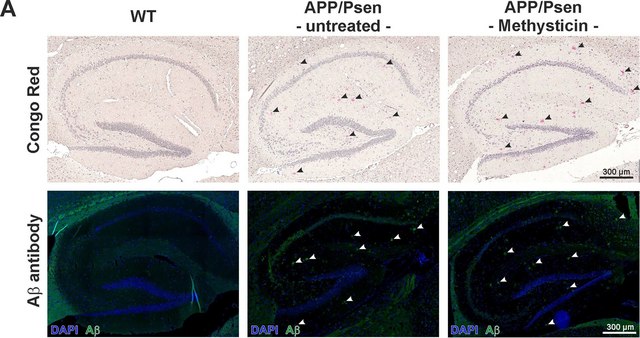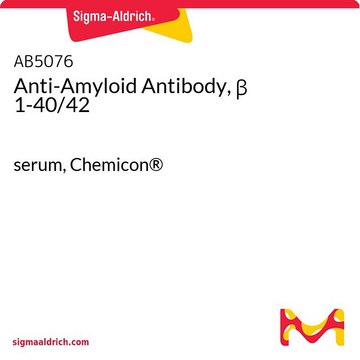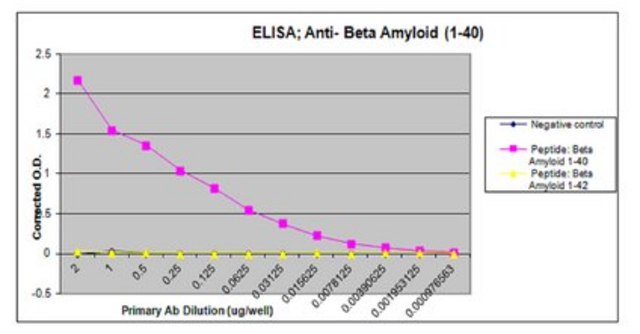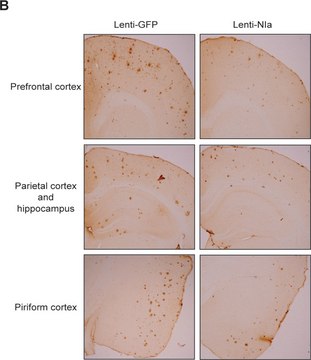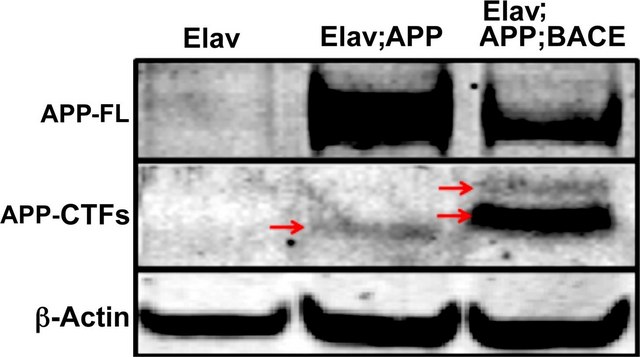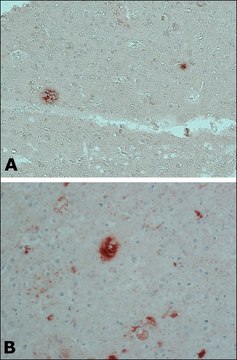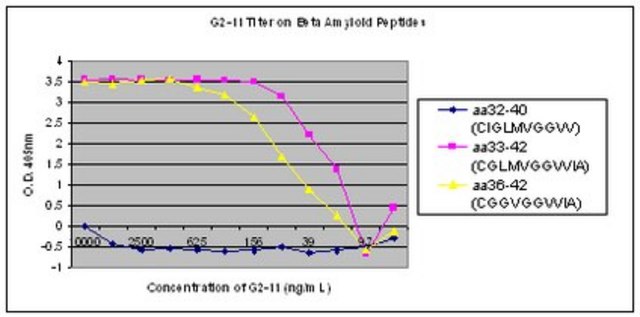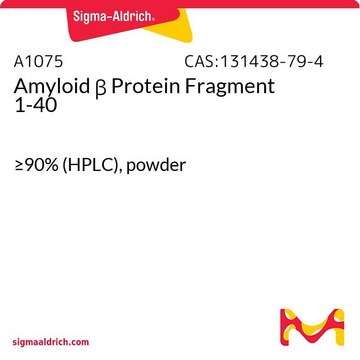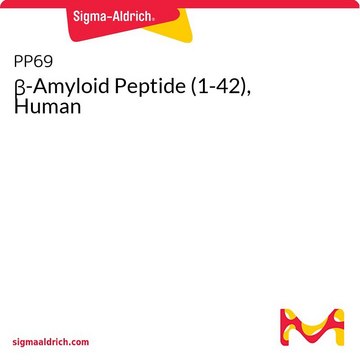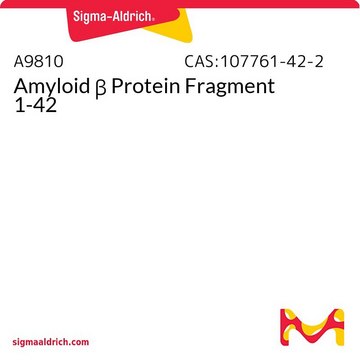推荐产品
产品名称
抗淀粉样蛋白抗体,β1-40, Chemicon®, from rabbit
生物来源
rabbit
质量水平
抗体形式
affinity purified immunoglobulin
抗体产品类型
primary antibodies
克隆
polyclonal
纯化方式
affinity chromatography
种属反应性
mouse, human
制造商/商品名称
Chemicon®
技术
ELISA: suitable
immunohistochemistry: suitable
western blot: suitable
UniProt登记号
运输
dry ice
靶向翻译后修饰
unmodified
基因信息
human ... APP(351)
一般描述
与阿尔茨海默′病(AD)相关的脑和血管斑块主要由β淀粉样肽(Ab)组成。Ab衍生自淀粉样前体蛋白(APP)的裂解,长度从39到43个氨基酸不等。Ab[1-40],Ab[1-42]和Ab[1-43]肽分别来自残基40、42和43后APP的裂解。裂解是在最后一个APP处理步骤中通过γ-分泌酶进行的。Ab[1-40]、[1-42]和[1-43]肽是AD中斑块和缠结的主要成分。已经开发了Ab抗体和肽作为阐明AD生物学的工具。
特异性
识别β-淀粉样蛋白1-40。在阿尔茨海默′病(AD)中引起记忆和认知丧失的最重要和最初始的步骤之一是淀粉样蛋白前体蛋白(APP,21号染色体)的蛋白水解裂解,释放短的40、42、&43氨基酸肽(β淀粉样蛋白1-40、1-42和1-43)。β-淀粉样蛋白的聚合和随后的神经元沉积(淀粉样蛋白)导致参与记忆和认知的神经元变性。免疫原肽显示与β-淀粉样蛋白1-28和β-淀粉样蛋白12-28的同源性。没有观察到与CGRP的交叉反应性。
免疫原
来自人β-淀粉样蛋白1-40的C末端的7个氨基酸肽序列。
应用
研究子类别
神经退行性疾病
神经退行性疾病
研究类别
神经科学
神经科学
蛋白质印迹:1-10 μg/mL(化学发光技术)
免疫组化:使用福尔马林或多聚甲醛固定的阿尔茨海默′脑组织为10-50 μg/mL。
ELISA:1:10,000-1:100,000(50-100 ng免疫原肽/孔)
最佳工作稀释度必须由最终用户确定。
免疫组化:使用福尔马林或多聚甲醛固定的阿尔茨海默′脑组织为10-50 μg/mL。
ELISA:1:10,000-1:100,000(50-100 ng免疫原肽/孔)
最佳工作稀释度必须由最终用户确定。
该抗淀粉样蛋白抗体β,1-40经过验证可用于ELISA、IH、WB中检测淀粉样蛋白。
外形
亲和纯化的免疫球蛋白。 含0.1%BSA的PBS液体,不含防腐剂。
免疫亲和纯化
储存及稳定性
自收到之日起在-20°C可稳定保存1年。避免反复冻融。为了最大程度地回收产品,在融化后和取下盖子之前,将原始样品瓶进行离心。
其他说明
浓度:请参考批次特异性浓缩物的分析证书。
法律信息
CHEMICON is a registered trademark of Merck KGaA, Darmstadt, Germany
免责声明
除非我们的产品目录或产品附带的其他公司文档另有说明,否则我们的产品仅供研究使用,不得用于任何其他目的,包括但不限于未经授权的商业用途、体外诊断用途、离体或体内治疗用途或任何类型的消费或应用于人类或动物。
未找到合适的产品?
试试我们的产品选型工具.
储存分类代码
12 - Non Combustible Liquids
WGK
WGK 2
闪点(°F)
Not applicable
闪点(°C)
Not applicable
Sylvia E Perez et al.
The Journal of comparative neurology, 521(18), 4318-4338 (2013-07-25)
The two major histopathologic hallmarks of Alzheimer's disease (AD) are amyloid beta protein (Aβ) plaques and neurofibrillary tangles (NFT). Aβ pathology is a common feature in the aged nonhuman primate brain, whereas NFT are found almost exclusively in humans. Few
Combined treatment with a BACE inhibitor and anti-A? antibody gantenerumab enhances amyloid reduction in APPLondon mice.
Jacobsen, H; Ozmen, L; Caruso, A; Narquizian, R; Hilpert, H; Jacobsen, B; Terwel et al.
The Journal of Neuroscience null
Dendritic spine density, morphology, and fibrillar actin content surrounding amyloid-? plaques in a mouse model of amyloid-? deposition.
Kirkwood, CM; Ciuchta, J; Ikonomovic, MD; Fish, KN; Abrahamson, EE; Murray, PS; Klunk, WE; Sweet, RA
Journal of Neuropathology and Experimental Neurology null
Sylvia E Perez et al.
Neurobiology of aging, 39, 195-201 (2016-03-01)
Amyloid beta (Aβ) and tau pathology have been described in the brains of captive aged great apes, but the natural progression of these age-related pathologies from wild great apes, including the gorilla, is unknown. In our previous study of Western
Zhiping Mi et al.
Journal of neuropathology and experimental neurology, 75(9), 868-876 (2016-07-23)
Tenascin-C (TN-C) is an extracellular matrix glycoprotein linked to inflammatory processes in pathological conditions including Alzheimer disease (AD). We examined the distribution of TN-C immunoreactivity (ir) in relation to amyloid-β (Aβ) plaques and vascular Aβ deposits in autopsy brain tissues
我们的科学家团队拥有各种研究领域经验,包括生命科学、材料科学、化学合成、色谱、分析及许多其他领域.
联系技术服务部门